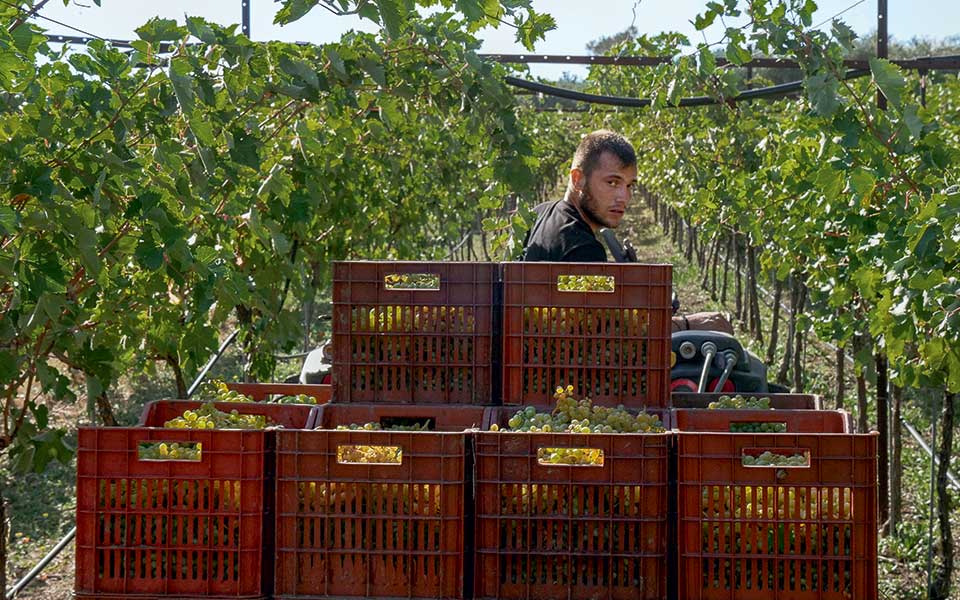A couple of vultures (skares in the local dialect) glide low overhead, accompanied by the eerie howl of a fierce wind, greeting me with an unsettling welcome as I arrive in Temenia in the White Mountains. The vine leaves of the ancient, pre-phylloxera vineyard shimmer in vibrant green, clinging to the first delicate shoots that sway restlessly in the breeze. Thanks to endless winter sunshine, cool water trickling down from the island’s towering snow-capped peaks, and the (for now) perfect Mediterranean climate, Cretan vines are continuing to thrive. Most of the island’s vineyards are located in the Irakleio region, around Archanes, Peza, and Dafnes, although every part of the island boasts vineyards; on Crete, there are over 220,000 hectares of grapes, from Sitia to the mountains of Rethymno and Hania.
Wine is deeply woven into the fabric of Cretan life, an essential and enduring part of its history, exerting a profound influence on social life and trade for over 3,500 years. This deep-rooted connection was revealed decades ago by excavations at Vathypetro, which uncovered a Minoan wine press dating back to around 1580 B.C. Later in its history, during the rule of the Republic of Venice, which lasted from 1211 to 1669, more than 100,000 containers of Malvasia wine were exported overseas from Candia (modern-day Irakleio).
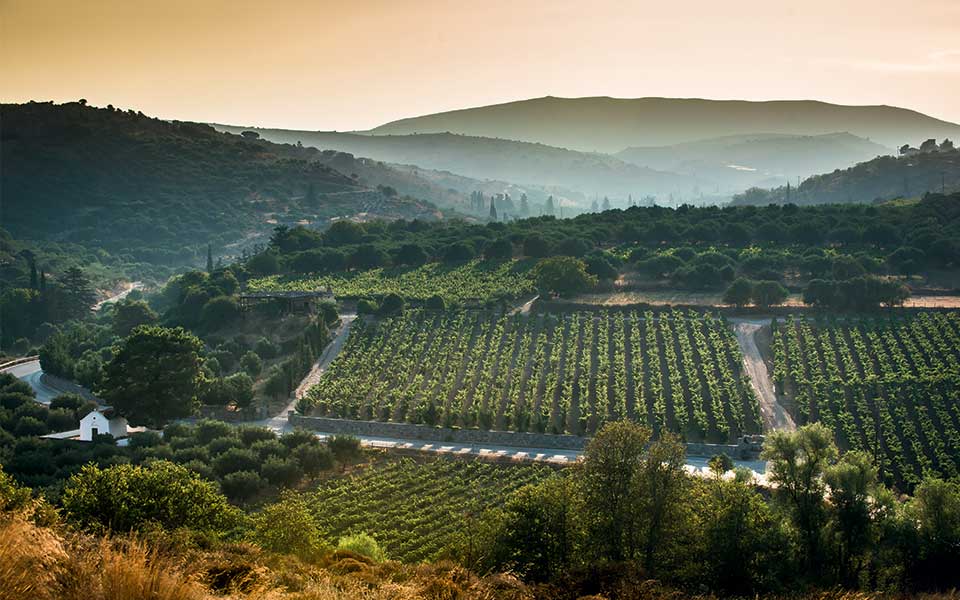
© Wines of Crete
From Animal Skins to Bottles
In more recent times, winemaking has become a family tradition passed down through generations. Many of today’s producers are fourth or fifth-generation winemakers, descendants of families who have long been involved in viticulture, whether as a primary business or a side occupation. One such individual is Nikos Miliarakis, whose great-grandfather was the wine pioneer Antonakis Miliarakis. Around 1900, Antonakis ran a taverna in Peza, serving travelers who journeyed from the south of the region to Irakleio, offering them a place to stay after the city gates closed each night. Antonakis’ taverna became renowned for its wine, believed to have been made from the grape variety Marouvas, a celebrated variety of that era. At the time, wine was transported in animal skins or small clay pots on carts drawn by animals. In 1932, Antonakis’ four sons established a winery, selling wine in both skins and barrels.
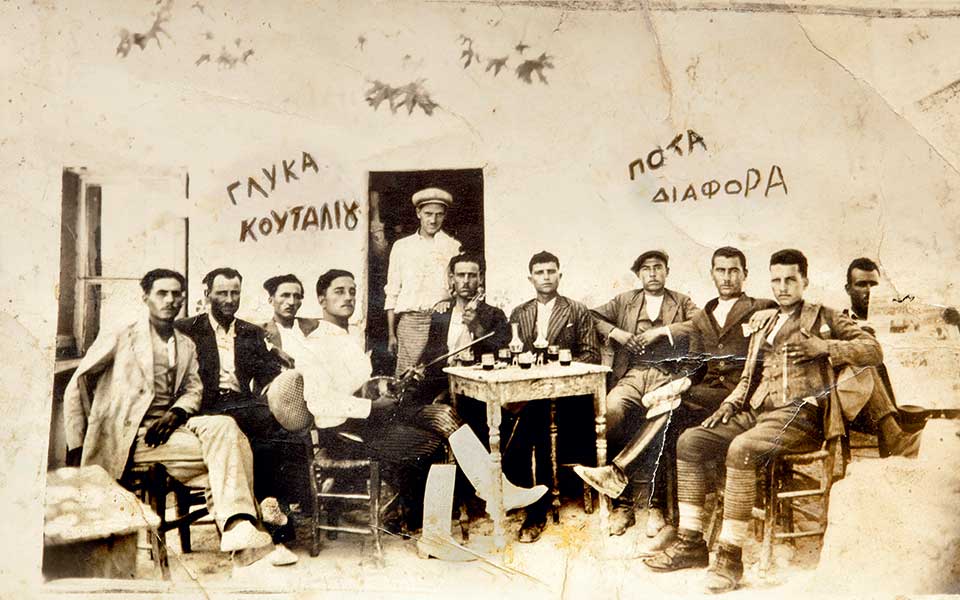
Two Charismatic Pioneers
“After completing my law degree in Athens, I worked at a bank, but I decided in late 1987 to leave that job as I recognized a growing potential in tourism,” says Margarita Siganou, CEO of Siganos S.A. “I saw a business opportunity and joined my father’s beverage company, where he was a distributor for major brands. Important Cretan hotels such as Minos Beach, Elounda Beach, Elounda Mare and Mirabello were already up and running by then. I realized there was a need to cater to the clientele of these hotels, so I decided to focus on premium products.” She and her team became advocates for the potential of the Cretan vineyard, believing in the power of indigenous grape varieties and supporting local producers in their efforts to improve the quality, appearance, and identity of their products. The steady rise in sales convinced restaurant owners to prefer and promote local wines, with the strong argument that no other wine complements Cretan cuisine better than Cretan wine. Margarita truly believed in this added-value factor of Cretan wines and worked hard to establish local producers in the market, a mission she continues to pursue today.
Until the early 1990s, Cretan wine meant multi-varietal blends. Most vineyards were field blends. The Peza Union, the Irakleio and Archanes Unions, Creta Olympias, and other important producers such as Alexakis, who made the famous Vin De Crète, and Boutari produced such blends. These wines did contain Vidiano and Vilana, but no one paid much attention to those native varieties at a time when the market was loudly demanding international grapes – French grapes, which were considered superior, in particular.

© Effie Paroutsa

© Christos Manioros
The conversation around local grapes didn’t begin in earnest until after 1996, and anyone producing single-varietal wines was seen as eccentric. In 1998, Manolis Lyrarakis bottled Mystikos Deipnos (The Last Supper), made from Kotsifali and Syrah, one of the first great examples of the new era for Cretan wine. Five pallets of this wine were sold to Avli, a fine dining restaurant in Rethymno.
This gastronomic haven in the heart of the city had been founded in 1987 by Katerina Xekalou. At the time, it was a bold move. Katerina, a student at the Athens Law School, would return to her hometown of Koumia, Rethymno, every summer. Seeing an abandoned, almost crumbling building with a magical garden in Rethymno’s old town, she decided to create the restaurant of her dreams there. With the enthusiasm of youth, a lack of fear, and all that she had learned of her grandmother’s and mother’s cooking, she set out to serve only the best at Avli: from tender kid goat to aged graviera cheese to filet mignon with Madeira sauce, and even French desserts.
As for the wine, up until 1991, she served the five bottled wines available on the island, including Boutari’s Lac Des Roches and Kaligas’ Ruby. When the Hatzimichalis Winery emerged, she purchased large quantities of their labels, and in 1993, Avli hosted the first presentation of the experimental wines of the Spithari label from Hatzimichalis. Katerina had planted the seed for Crete’s first Wine Library and one of the first wine bars in Greece, starting with Avli’s cellar, which later became an independent entity. By 2000, her establishment boasted 470 wine labels from all over the country. Only years later did she learn through a chance conversation that the building that housed her restaurant, which dated back to 1630, had in fact once been the wine warehouse of a local merchant. Today, Avli’s Wine Library offers 140 labels, with a strong presence of Cretan wines among them.
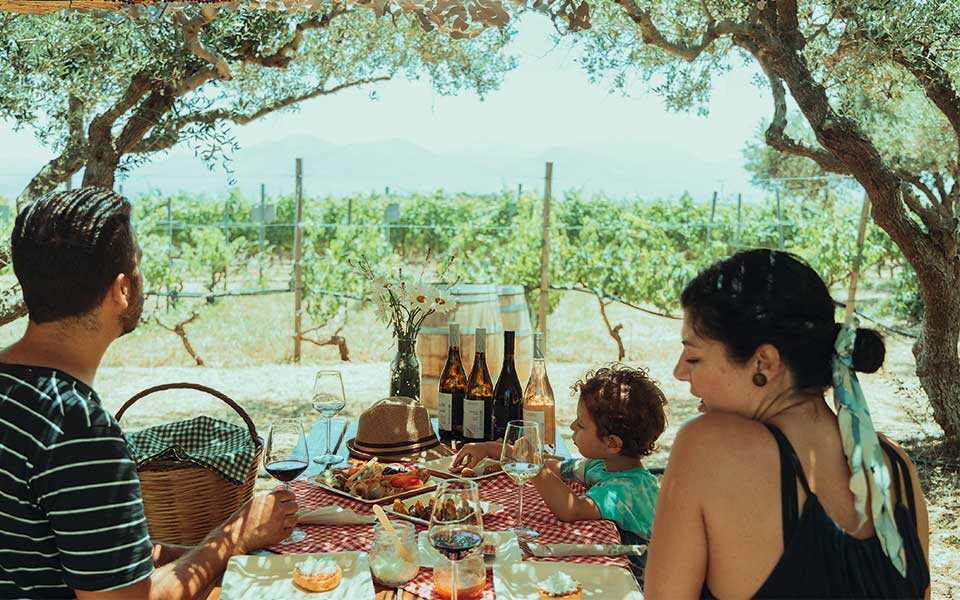
Strength in Unity
In the early 2000s, many second and third-generation winemakers returned to Crete after studying or working abroad, eager to take up the reins at their family wineries. During this time, the idea of collective action began to take shape. A new generation had emerged, serving as the catalyst for the future of Cretan wine. “The key was that we connected; we were collaborators and communicated well. That’s why we encouraged other small, medium or large wineries, including those in western Crete, to join forces,” recalls Nikos Douloufakis. Along with Manolis Lyrarakis, Dimitris Tamiolakis, and Nikos Miliarakis, they were among the first to discuss the future of Cretan wine, focusing on the potential of native grape varieties and the importance of wine tourism. By 2006, after many fruitful discussions, they established the Wines of Crete network, with 16 wineries signing on as founding members, united in raising the profile of Cretan wine and promoting the island’s wine tourism industry.
Today, the Wines of Crete network has 36 member wineries, primarily from Irakleio and Lasithi, with some cooperatives also involved. Wineries from Hania and Rethymno operate under their own association, although they regularly engage in productive discussions that might lead to a unified island-wide network in the future.
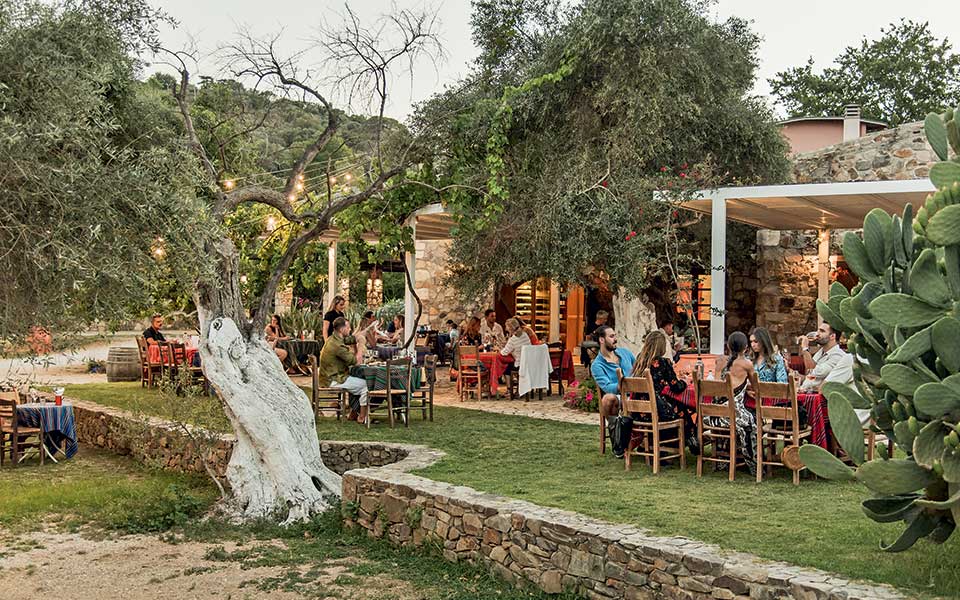
© Vicky Tsatsampa
So, what did this collective effort achieve? They succeeded in establishing Crete as a wine-producing region of significant value, thanks to the island’s trove of ancient grape varieties, which they proudly brought to the forefront. Varieties such as Vilana, Vidiano, Dafni, Thrapsathiri, Kotsifali, Liatiko, Malvasia, Mandilari, Muscat of Spina, Plyto, and Romeiko – once scattered across vineyards with their origins nearly forgotten – were rediscovered. “After phylloxera hit in the 1970s and ’80s, vine growers salvaged what they could and took cuttings from healthy vines to plant in new vineyards. But these cuttings were taken from field-blend vineyards, so that’s why, in vineyards ostensibly planted with Vilana in the 1980s, you also find Thrapsathiri, Vidiano and Tahta, although the growers didn’t necessarily intend to replant them or even know that they had,” explains Douloufakis, a fourth-generation winemaker who has long championed the island’s native varieties. It was only later, with the new network of winemakers, that a concerted effort was made to isolate these native varieties, revive entire vineyards, and begin producing the first single-varietal wines from Crete.
Soon enough, attention turned toward Crete, both from Greece and abroad, as these dedicated producers, united in their mission, unveiled the treasures of their fertile land. Even though the names of the wines might be hard for foreign consumers to pronounce or remember, Cretan wines began to be exported widely to countries such as Germany, the US, and beyond. Today, some wineries export more than 60% of their production. Vidiano has emerged as their flagship white wine, while Kotsifali blended with Syrah is among the most popular combinations, featured by many producers. Liatiko, too, has made a name for itself.
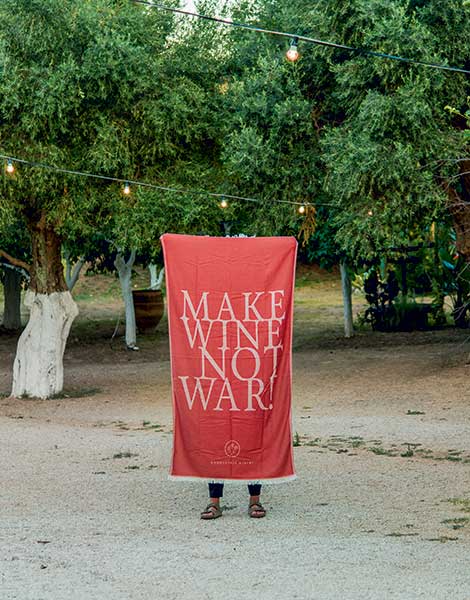
© Vicky Tsatsampa
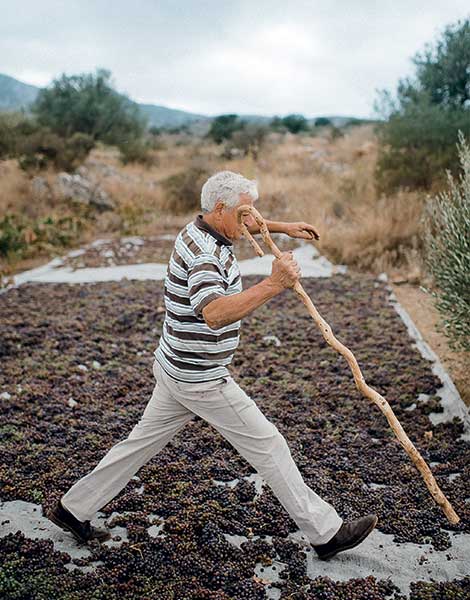
© www.andreasmarkakis.com
Wines of Distinction
Over the years, certain wine labels have emerged as standouts for their distinctive style or unique characteristics. In no particular order, let’s start with Melissinos, an unusual blend of Thrapsathiri and Sauvignon Blanc, crafted by the Paterianakis family from the village of Melesses. The Paterianakis family, who established Crete’s first organic winery in 1996, was initially run by Giorgos and Popi Paterianakis; now their daughters, Emmanuela and Niki, have taken the helm. One of their labels, 3.14, is a natural wine, and their latest release is an Assyrtiko from the 2021 vintage, aged for a year in barrels and presented in magnum bottles. The Paterianakis sisters are also producing bottled tsikoudia, a strong spirit, releasing two single-varietal versions made from Kotsifali and Vidiano respectively.
Other noteworthy wines include the ever-reliable Diamantopetra from Diamantakis, Kedros from Liatiko, Plakoura from Mandilari, and Vilana Pyrovolikes from Lyrarakis – arguably one of the finest Vilanas. Lyrarakis Winery, known for its beautifully organized and welcoming estate in Irakleio, is a must-visit for those who enjoy experiencing wines in their place of origin. In Rethymno, Moschato Spinas by Kourkoulou, which won a Gold Medal at the Thessaloniki Wine Competition, has quickly made a name for itself, although the winery that produces it is only six years old, and has earned a place on the shelf next to the well-established Moschato Spinas from Strataridaki, another lively expression of the grape.
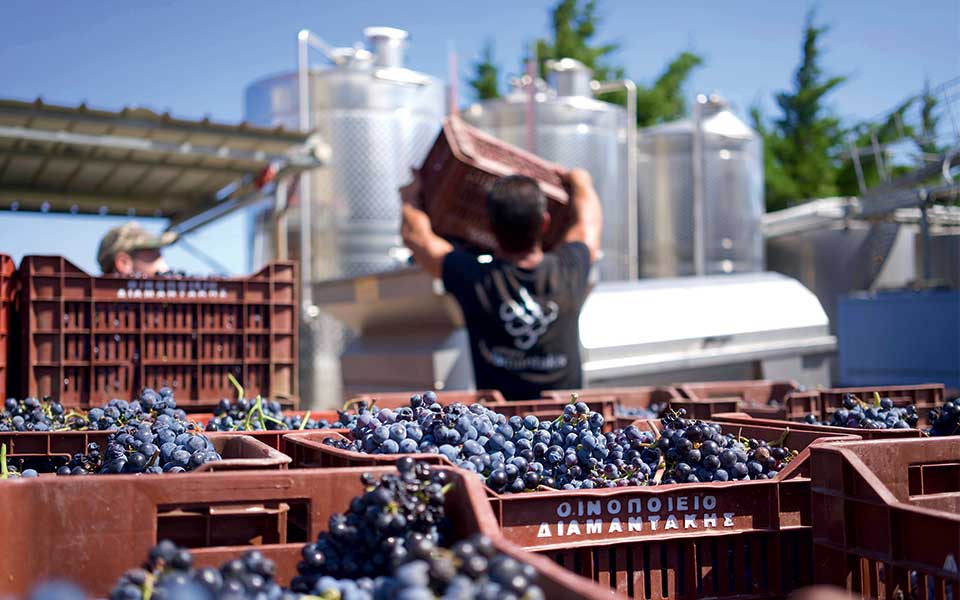
In Hania, Euphoria by Dourakis is a sweet wine that highlights the potential of Romeiko, but when I think of Romeiko, I can’t help but think of Vatolakkos, home to Manousakis Winery, known for its masterful handling of Mediterranean varieties. Here, they produce one of the most flavorful Mourvèdres and one of the most delicate Roussannes in the Mediterranean basin. But have you tried their unique, salty, and mineral-driven Romeiko? Alexandra Manousakis has, since 2007, been busy building a world of her own on the foundations of her family’s home – one that combines high-quality wine, authentic Cretan cuisine, art in many forms, and a warm, welcoming atmosphere. What began as a tiny winery, with Alexandra fresh from Washington and barely speaking Greek, has become a model estate. The wine that bears her own name, Alexandra’s, is a fantastic value-for-money option made from Syrah, Mourvèdre, and Grenache, and features a label designed by Alexandra herself.
A few kilometers to the east, winemaker Nikos Karavitakis oversees 150 hectares of family-owned land, with another 150 hectares from partner growers. Since taking over in 2010, he has focused on single-vineyard wines and native varieties. “We’ve put a lot of emphasis on Vidiano and Liatiko, two varieties I strongly believe in. We’ve quadrupled our production, and now nearly 40% of our output is exported,” Karavitakis notes as he heads to the US to talk new agreements with wine buyers there. “We’re gradually releasing a range of low-intervention wines, using native yeasts from Vidiano, Liatiko, and Kotsifali, while also working on a series of Romeiko-based wines to produce a Marouvas using traditional methods.” If you’re curious about Kotsifali at its most elegant, try the 2018 Kotsifali Native Yeasts. Also worth noting are Vidiano by Iliana Malihin, Moschato Spinas Aori, Vidiano by Thalassinos, and the outstanding organic Vidiano by Zouberakis. Each one is exceptional.
At the 2023 Oinotika Wine Fair in Irakleio, I counted more than 36 producers; the island is estimated to have around 55 in total. I tasted over 40 wines in just a few hours, yet I barely scratched the surface of Crete’s wine production. What stood out most was that nearly every producer offers around 15-18 labels, ranging from French to native varieties, and from tank-aged to barrel-aged wines. There are some that are mass-produced, others that are carefully crafted in limited quantities at rural outposts, and still others that fall somewhere in between: wines that aren’t necessarily for everyday drinking but aren’t strictly gastronomic, either. I won’t dwell on the occasional missteps. I always approach Cretan wines with optimism. But after all these years of showcasing their treasures, perhaps the time has come for Cretan winemakers to push the envelope further and show the world how much more they can achieve with their extraordinary heritage.

